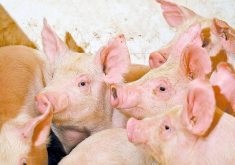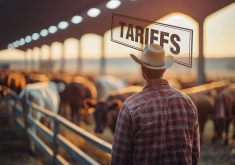As our industry looks at how to respond to the decline in its competitive position, it might be worth studying what happened in the UK.
Bernie Peet is president of Pork Chain Consulting Ltd. of Lacombe, Alberta, and editor of Western Hog Journal.
The British pig industry has had a tough time over the last decade, with challenges ranging from a unilateral ban on sow stalls to Foot and Mouth Disease (FMD) and increasingly strict environmental legislation. It has also waged a constant battle for fair prices and clear labelling with the powerful “big four” retailers that dominate the British retailing scene.
Read Also

Horns aren’t unlocking anytime soon on livestock transport standards
Standards good enough meet the definition of “humane” animal transportation still vary widely between what what industry wants, what animal rights advocates want and, between the two, what federal regulators decide is good enough.
But now, after 10 years of attrition, there are signs of a revival in the industry’s fortunes and even some indication of future growth.
Back in 1997, just before the “pig crisis” of 1998-9, the UK herd stood at over 800,000 breeding animals. It was in the process of adapting production systems to include group sow housing, a process the industry was given just six years to complete under UK legislation banning sow stalls. Many producers invested heavily in new housing, while some set up outdoor herds instead. Two years of low profitability (1998-9) took its toll and then, just as things seemed to be recovering, FMD struck in 2001, resulting in the slaughter of millions of pigs.
Quality focus
During the early 1990s, the industry developed a comprehensive quality assurance program in response to retailer demands. With the move towards group sow housing and defined high standards of pig welfare – including no castration – industry leaders felt there was a good story to tell the British consumer and increasingly focused on identifying home-produced products in the store. The Quality Standard Mark for pork, bacon and ham, developed by the producer-funded organization called the British Pig Industry Executive (BPEX), became extensively used on retail packaging.
However, the retailers also wanted to be able to source pork products from other parts of Europe and offer lower-priced imported products to their customers. In many cases their labelling of imported product has been misleading and sometimes implied that it was of British origin when it was not. The National Pig Association (NPA) has campaigned long and hard against the labelling practices, with some success, in addition to working with BPEX to promote the virtues of British pork.
With so many challenges, it’s not surprising that there has been huge rationalization, both in the production sector and in processing.UKbreeding pig numbers have dropped to 436,000, a 45 per cent drop over 10 years, with Scotland and Northern Ireland showing a 50 per cent fall. But over the last couple of years, the attrition seems to have stopped and in 2008, when many industries around the world suffered major setbacks, sow numbers barely changed. Today the industry is a very different beast from its former self and has a new confidence, despite some continuing challenges.
“Stand By Your Ham”
A smaller industry has resulted in a major drop in self-sufficiency between 1997 and 2007, with pork falling from 118 per cent to 69 per cent and bacon and ham from 51 per cent to 42 per cent. The focus in now on higher added value and premium products. There is a range of branded fresh pork products on the retail shelf, such as free range and outdoor reared (40 per cent of British sows are now kept outdoors). Consumer surveys by BPEX suggest that the number of meals eaten that include premium red meat products tripled in the three years to 2007. There has been a massive increase in the consumption of premium sausages over the last 10 years and the good old “British Banger” is now almost a delicacy. Not only has the range of premium products grown rapidly in the major retailers, but also in specialist butchers, farm shops and delicatessens.
As the pork industry plunged into crisis during 2007-8, the British strategy was to appeal for support from domestic consumers, launching a highly successful “Pigs Are Worth It” campaign, which included a wide range of initiatives to increase loyalty to British products. One of the most high profile was the release of the song “Stand By Your Ham”, performed by people from the industry, which resulted in huge publicity all around the world. BPEX also engaged the support of celebrity chefs, including Jamie Oliver, who produced a one-hour TV show called “Jamie Saves Our Bacon” which extolled the virtues of British pork. There is no doubt that the profile achieved by the industry in 2008 was a major contributor to maintaining demand and achieving good pig prices, even if high feed prices wiped out any profit for producers.
Currently, the price is around 1.50/kg or C$2.70 and with lower feed prices, producers are making a good margin. Some of the recent good fortune is due to the reversal in the British Pound’s value relative to the Euro, which has made imports more expensive. But the cautious optimism in the industry at the moment is mainly down to the industry and its representative bodies having worked so hard for a long time, having strong leadership and being incredibly creative in their promotion of the industry and its products.
So, with Canada having to rethink its position as a low-cost commodity pork producer, are there lessons that can be learned from the Brits? I think there are. In future, if we can’t compete on cost alone, we will have to produce more premium products and increase value in the pork production chain. Also, we have neglected our home market in the thrust for exports and need to be more creative about how we engage the consumer in order to create loyalty to Canadian pork. The Canadian Pork labelling initiative is a start, but rather basic. As our industry looks at how to respond to the decline in its competitive position, it might be worth studying what happened in the UK.














